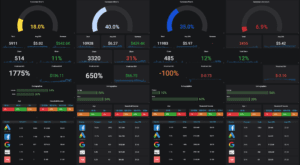Measuring ROI can be tricky but measuring on content is even harder. There are rules that state that it often can take 7-10 touchpoints to acquire a customer. How can you be sure if your content strategy is working if it's not measured? What are some rules that can be applied to measure ROI for content?
In the marketing world, it's often ‘throw !@#$ on the wall and see what sticks'. The problem with this approach is that marketing is a creative endeavor. There's no shortage of content that can be created, no shortage of new hashtags that can be created. The challenge is determining what works and why. Someone could blog all day long and never connect with a customer. If it's not working, why do it?
Most People Don't Know if it's Working
A few months ago I met a marketing coordinator at an event who was very interested in how their company could use AI with their marketing. I sent her one of my whitepapers about common uses of AI. Then I took a look at their marketing. (Yes – I broke my own rule of researching a customer first.) Anyways.
This was a flooring company so by default I wasn't expecting a lot. Generally these types of websites don't look great – they look like they use website templates from 1999 and this was no exception. Then I went to their LinkedIN page and saw it.
Every week, some person in their company posts a LinkedIN article highlighting some flooring product they sell. Basically they copy and paste the marketing material from the flooring manufacturer (including the flooring manufacturer's stock photos.) A PERSON invests time in this! I don't understand. It's not impressive, it's boilerplate, and I can't imagine it gets any leads. AND to add insult to injury – it redirected to the manufacturers website.
Why would they invest time in this?
Long story short, they don't know better. They aren't measuring. They are just ‘creating content' for the sake of creating content. I don't understand this method of content marketing. Just creating content isn't helpful. Creating content for the sake of being helpful is helpful. This company could have posted projects where they use the product, they could have posted their experience about which products they like to use and why. They could have even just posted finished projects and THAT would have been infinitely more valuable than re-posting manufacturer's content.
I recently signed up for a personal training service and found them because I found a helpful blog article on how to learn how to do a pull-up.
During the onboarding process they asked me how I found them and I told them about the article. Their reply was that a lot of people find them that way which wasn't surprising – it was highly ranked on Google.
But – here's the question.
Shouldn't they have known how I found them? Asking me the question certainly provides some insights (how do I remember that I found them) versus actual data.
In this day and age it's easy enough to understand where traffic comes from and what they looked at but virtually no companies are doing this.
Attributing Sources
When creating content and links, use UTM codes to attribute the source. The nature of UTM codes is that if content gets shared across different social channels then this can quickly become unreliable.
For example, you post something on Twitter which is subsequently shared on Facebook. If you only use the UTM code without looking at the underlying referral source, it's going to be wrong.
We generate dynamic UTM codes that identify the original content link, source, medium, and campaign information so this does track the initial source of the content, but then it doesn't get skewed by shares along the way because it's easy enough to see that the traffic came from a Facebook link. This gives us a way to see how content is organically shared and which social media channels lead to conversions.
Weighted Measurements
From there it's important to create a weighted measurement system that attributes the initial content heavier than subsequent calls to action and content.
For example, you can attribute 40% of the revenue to the landing page or blog article, 20% of the revenue to the closing page (although if you have a pricing page where someone has to look at this before checking out this may not be the right metric), then attribute the remainder to intermediate pages viewed throughout the customer education process.
One area where this may get murky is with retargeting campaigns. A customer may see an initial link, get targeted in a remarketing campaign, then finally close the sale on the next go-around. In that case you may want to weight 20% to the first lead page, 20% to the retargeting campaign and then the remainder is divided among the other pages and calls to action along the way.
Negative ROIs
Initially any article published should have a negative ROI, I think it's good. The goal of content is to create value over the the long haul of your business. If you can track the COST of creating the content, that's even better. This will enable you to gauge the relative quality of your content and help you archive articles that are causing bounces. Because content all works together, it's important to measure all of the views (and remove BOT-based traffic from the metrics so you truly are counting eyeballs.)
The important part here is to actually track each page individually AND collectively. By tracking individually, you can quantify ROI and bounce rates. By tracking collectively, you can create smarter recommenders that identify that certain blog articles when viewed together improve conversion rates.
How to Track
Unfortunately most of the free tools don't provide this level of detail. We tried to leverage certain APIs with the hopes that we could extract insights from common website activity platforms. What we found was the most useful was leveraging website server logging directly to correlate usage, referrers and other key metrics, then augmenting it with information provided by free website analytics tools to get even deeper insights.








